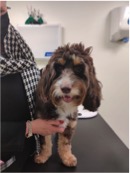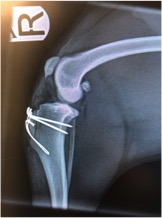At Oakhill we see many limping dogs, most of which fortunately resolve simply with rest and pain relief medication. Sometimes however, this is not the case, and rest and medication is not enough.

Tilly, a lovely cocker spaniel cross poodle came to see us at our Kirkham branch as she had been suffering from a sore hind leg causing her to limp. This was not good for poor Tilly as she is a very active and bouncy dog!
After a thorough clinical exam Tilly was diagnosed with very movable knee caps (patellae) that dislocate from their normal position in the groove at the bottom of the thigh bone (femur). This is known as patella luxation which, if serious enough and left untreated, can result in arthritis. It is usually a disease that an animal develops when they are young, due to the shape (or conformation) of their legs as they grow and is influenced by genetics – i.e. can be passed from affected parent dogs. This disease can affect many different breeds of dog (and cats for that matter), however breeds such as Poodles, Chihuahuas, many Terriers and French bulldogs tend to be over represented.
Initially Tilly was treated with pain relief medication and rest however her lameness did not improve. Therefore Tilly underwent x-rays to rule out any other diseases and ensure she was a good candidate for surgical treatment, which she was.

Tom, one of our vets, undertook a surgical technique on Tilly called a tibial tuberosity transposition and wedge sulcoplasty (what a mouthful!) which put simply, deepens the grove the knee cap sits in and realigns part of the shin bone (tibial crest) to pull and keep the knee cap in the correct position. This is done by cutting the shin bone and pinning it in a slightly modified position.
Tilly has had to be kept well rested after the surgery- a hard task indeed! She has done very well and is no longer limping and back to her bouncy happy self.
Reference: O’Neill, D.G., Meeson, R.L., Sheridan, A. et al. The epidemiology of patellar luxation in dogs attending primary-care veterinary practices in England. Canine Genet Epidemiol3, 4 (2016)
